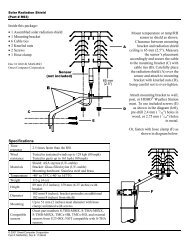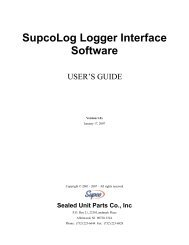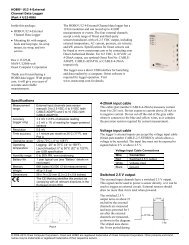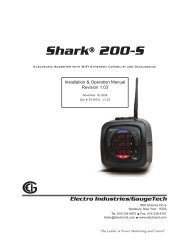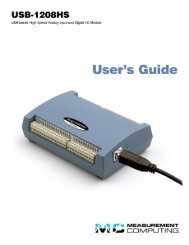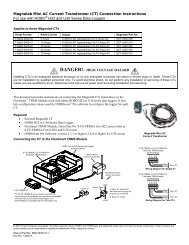USB-4301 User's Guide
USB-4301 User's Guide
USB-4301 User's Guide
Create successful ePaper yourself
Turn your PDF publications into a flip-book with our unique Google optimized e-Paper software.
<strong>USB</strong>-<strong>4301</strong> <strong>User's</strong> <strong>Guide</strong><br />
Functional Details<br />
Example 1<br />
Problem: The application generates an active low pulse every time a button 1 is pressed. You need a simple<br />
event counter to count button presses.<br />
Solution: Any of the counters can be configured to do this fairly easily. Do the following:<br />
1. Connect the input signal to the counter input pin, and select that input pin as the source for the counter.<br />
2. Program the counter to:<br />
o<br />
o<br />
o<br />
o<br />
o<br />
o<br />
o<br />
o<br />
Count negative edge transitions<br />
Count up<br />
No recycle<br />
Count in binary mode<br />
Reload from the Load register<br />
Disable special gate<br />
No gate control<br />
Make output control inactive<br />
3. Load the Load register with a value of 0 to start counting.<br />
Example 2<br />
Problem: An external device generates an active high signal while a switch is depressed. The switch is<br />
depressed for at most one second. You need to measure the time the switch is depressed with microsecond<br />
accuracy.<br />
Solution: Microsecond accuracy for one second requires counting to at most 1,000,000. However, each counter<br />
can count only to 65,535. You can use some counter features to cascade two of the counters in order to count<br />
higher. Configure Counter 1 and Counter 2 as follows:<br />
Configure Counter 1:<br />
1. Using InstaCal, configure the counter 1 source for 1 MHz. As shown in the "Internal frequency values"<br />
table on page 16, an internal base frequency of 1.0000 MHz corresponds to FREQ1.<br />
The internal base frequency of 1 MHz provides an ideal way to measure time to the microsecond, since<br />
1 count at 1 MHz equals 1 microsecond.<br />
2. The counter can count either up or down, so for this example set the counter to count up.<br />
3. The counter should count only while the input signal from the switch is active. To do this, connect the input<br />
signal to the gate 1 pin (GAT1), and configure the counter gate control for active high level Gate n.<br />
4. Load the Counter 1 Load Register with a value of zero, since you want the counter to reach as high a count<br />
as possible before reaching TC.<br />
5. To cascade Counter 1 with Counter 2, turn Recycle mode on. This is done so Counter 1 continuously<br />
counts to TC, then wraps around and starts counting at 0 again.<br />
6. Set reload to always load from the Load register, since you want to restart at 0 after every TC.<br />
7. Enable binary mode.<br />
8. Set the Counter 1output to inactive; Counter 1 requires no special gating.<br />
1 For more information about debouncing mechanical switches, refer to the "Low pass to de-bounce inputs" section<br />
in MCC's <strong>Guide</strong> to Signal Connections . This document is available on our web site at<br />
www.mccdaq.com/signals/signals.pdf.<br />
19







